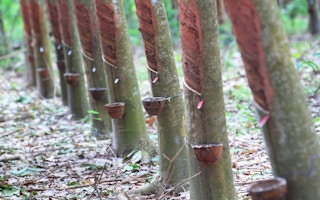Surging demand for natural rubber is decimating some of the world’s most endangered forests, putting wildlife and critical ecosystem services at risk, warn scientists writing in the journal Conservation Letters.
Reviewing a large body of published research, Eleanor Warren-Thomas of the University of East Anglia and colleagues detail the crop’s expansion across across Southeast Asia in recent decades, pointing out that four biodiversity hotspots have been particularly impacted: Sundaland (Malay Peninsula, Borneo, Sumatra, Java, and Bali), Indo-Burma (Laos, Cambodia, Vietnam, Myanmar, Thailand, and parts of Southwest China), Wallacea (Timor Leste and islands of eastern Indonesia including Sulawesi), and the Philippines.
Noting that rubber cultivation has sharply accelerated in the past decade, they estimate that projected rubber demand could require another 4.3-8.5 million hectares of land by 2024, depending how efficiently rubber is grown.
“Rubber can thrive across a wide range of climate and soil conditions across Southeast Asia, and could replace a whole range of forest types containing large numbers of globally threatened and unique species,” said Warren-Thomas in a statement. “Protected areas have already been lost to rubber plantations. For example, more than 70 per cent of the 75,000 hectare Snoul Wildlife Sanctuary in Cambodia was cleared for rubber between 2009 and 2013.”
“
Rubber grown on deforested land is not treated any differently in the market to rubber grown in a more sustainable way. This is misleading, especially when some products made from natural rubber are labelled as an ‘eco-friendly’ alternative to petrochemicals.
Eleanor Warren-Thomas, research, University of East Anglia
While environmentalists have warned for years about the rapid expansion of rubber plantations at the expense of natural forests, the issue has generally been overlooked because rubber trees look like forests, especially when grown in low-yielding “jungle rubber” agroforest plots.
But the ecological impacts are nonetheless significant, especially when it comes to wildlife: the new paper shows rubber plantations are biological deserts relative to natural forests.
“Macaques and gibbons are known to disappear completely from forests which have been converted to rubber, and our review shows that numbers of bird, bat and beetle species can decline by up to 75 per cent,” said Warren-Thomas. Hunting in rubber forests and plantations can exacerbate losses.
The effects are most pronounced in industrial monoculture plantations, which have higher yields per hectare but offer fewer ecological niches and generally utilize more chemical inputs that end up in waterways.
“Conversion to rubber monoculture also has a knock on effect for freshwater species because fertilisers and pesticides run off into rivers and streams,” Warren-Thomas added. “In Laos, local people have reported dramatic declines in fish, crabs, shrimps, shellfish, turtles and stream bank vegetation. In Xishuangbanna, China, well water was found to be contaminated.”
The researchers also cite studies showing that relative to native forests, rubber plantations deplete soil moisture during the dry season, cutting water discharge.
Given the environmental impacts, the authors call for mechanisms for improved stewardship. They specifically highlight the Sustainable Natural Rubber Initiative (SNR-i), a new certification effort in the sector.
“Rubber grown on deforested land is not treated any differently in the market to rubber grown in a more sustainable way. This is misleading, especially when some products made from natural rubber are labelled as an ‘eco-friendly’ alternative to petrochemicals,” said Warren-Thomas. “We also found that because oil palm growers cannot get sustainability certification and access to major markets if they plant on deforested land, they are replacing rubber plantations with oil palm, displacing the rubber elsewhere, and adding to the total demand for land.”
“A Sustainable Natural Rubber Initiative (SNR-i) was launched in January 2015 – this now needs support from large tyre manufacturers, and attention from sustainability researchers to ensure it gains traction.”
Yet certification systems for other commodities like the Roundtable on Sustainable Palm Oil (RSPO) and the Forest Stewardship Council (FSC) have failed to capture more than a tiny fraction of their respective global markets, limiting their effectiveness in driving long-term change. Furthermore, these certification systems have been criticized by some ecologists for continuing to allow damaging practices, like deforestation and first-time logging of old-growth forests.
That suggests certification of growers may not be enough on its own, seemingly opening up the possibility that environmentalists could push major users of rubber — particularly tire, car, and airplane companies that consume 70 per cent of the world’s natural rubber — to establish “deforestation-free” policies like those increasingly being adopted for palm oil, soy, pulp and paper, and beef sourcing.
Those policies, which are generally underpinned by mainstream eco-certification standards, typically include traceability requirements as well as social and environmental safeguards that are extended throughout a company’s global supply chain.
The researchers also urge scientists to engage with the effort to clean up the rubber business to “ensure relevance to biodiversity conservation, with prevention of further rubber development in key natural forests the minimum prerequisite for continued access to lucrative western and brand-label markets.”
“Business-as-usual practice carries with it a significant danger that rubber development could destroy Indo-Burma’s remaining wildernesses,” they write.
“The speed and scale of the new rubber boom means environmental and social considerations have so far been sidelined, with a spate of protected area de-gazettement and evictions of marginalized local peoples. The current focal regions for rubber production in Sundaland, and its rapid expansion in Indo-Burma, make this an urgent issue of global conservation importance.”










